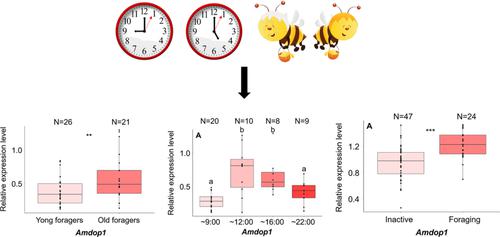当前位置:
X-MOL 学术
›
Genes Brain Behav.
›
论文详情
Our official English website, www.x-mol.net, welcomes your
feedback! (Note: you will need to create a separate account there.)
Forager age and foraging state, but not cumulative foraging activity, affect biogenic amine receptor gene expression in the honeybee mushroom bodies
Genes, Brain and Behavior ( IF 2.4 ) Pub Date : 2020-12-16 , DOI: 10.1111/gbb.12722 Tianfei Peng 1, 2 , Dennis Derstroff 2 , Lea Maus 2 , Timo Bauer 2 , Christoph Grüter 2, 3
Genes, Brain and Behavior ( IF 2.4 ) Pub Date : 2020-12-16 , DOI: 10.1111/gbb.12722 Tianfei Peng 1, 2 , Dennis Derstroff 2 , Lea Maus 2 , Timo Bauer 2 , Christoph Grüter 2, 3
Affiliation

|
Foraging behavior is crucial for the development of a honeybee colony. Biogenic amines are key mediators of learning and the transition from in‐hive tasks to foraging. Foragers vary considerably in their behavior, but whether and how this behavioral diversity depends on biogenic amines is not yet well understood. For example, forager age, cumulative foraging activity or foraging state may all be linked to biogenic amine signaling. Furthermore, expression levels may fluctuate depending on daytime. We tested if these intrinsic and extrinsic factors are linked to biogenic amine signaling by quantifying the expression of octopamine, dopamine and tyramine receptor genes in the mushroom bodies, important tissues for learning and memory. We found that older foragers had a significantly higher expression of Amdop1, Amdop2, AmoctαR1, and AmoctβR1 compared to younger foragers, whereas Amtar1 showed the opposite pattern. Surprisingly, our measures of cumulative foraging activity were not related to the expression of the same receptor genes in the mushroom bodies. Furthermore, we trained foragers to collect sucrose solution at a specific time of day and tested if the foraging state of time‐trained foragers affected receptor gene expression. Bees engaged in foraging had a higher expression of Amdop1 and AmoctβR3/4 than inactive foragers. Finally, the expression of Amdop1, Amdop3, AmoctαR1, and Amtar1 also varied with daytime. Our results show that receptor gene expression in forager mushroom bodies is complex and depends on both intrinsic and extrinsic factors.
中文翻译:

觅食年龄和觅食状态,而不是累积觅食活动,影响蜜蜂蘑菇体中的生物胺受体基因表达
觅食行为对于蜜蜂群体的发展至关重要。生物胺是学习和从蜂巢任务到觅食过渡的关键介质。觅食者的行为差异很大,但这种行为多样性是否以及如何取决于生物胺尚不清楚。例如,觅食年龄、累积觅食活动或觅食状态都可能与生物胺信号传导有关。此外,表达水平可能会根据白天而波动。我们通过量化蘑菇体(学习和记忆的重要组织)中章鱼胺、多巴胺和酪胺受体基因的表达来测试这些内在和外在因素是否与生物胺信号传导有关。我们发现年长的觅食者的Amdop1表达明显更高,Amdop2、AmoctαR1和AmoctβR1与较年轻的觅食者相比,而Amtar1显示相反的模式。令人惊讶的是,我们对累积觅食活动的测量与蘑菇体内相同受体基因的表达无关。此外,我们训练觅食者在一天中的特定时间收集蔗糖溶液,并测试受过时间训练的觅食者的觅食状态是否影响受体基因表达。从事觅食的蜜蜂比不活跃的觅食者具有更高的Amdop1和AmoctβR3/4表达。最后,Amdop1、Amdop3、AmoctαR1和Amtar1的表达也随着白天而变化。我们的研究结果表明,觅食蘑菇体中的受体基因表达是复杂的,并且取决于内在和外在因素。
更新日期:2020-12-16
中文翻译:

觅食年龄和觅食状态,而不是累积觅食活动,影响蜜蜂蘑菇体中的生物胺受体基因表达
觅食行为对于蜜蜂群体的发展至关重要。生物胺是学习和从蜂巢任务到觅食过渡的关键介质。觅食者的行为差异很大,但这种行为多样性是否以及如何取决于生物胺尚不清楚。例如,觅食年龄、累积觅食活动或觅食状态都可能与生物胺信号传导有关。此外,表达水平可能会根据白天而波动。我们通过量化蘑菇体(学习和记忆的重要组织)中章鱼胺、多巴胺和酪胺受体基因的表达来测试这些内在和外在因素是否与生物胺信号传导有关。我们发现年长的觅食者的Amdop1表达明显更高,Amdop2、AmoctαR1和AmoctβR1与较年轻的觅食者相比,而Amtar1显示相反的模式。令人惊讶的是,我们对累积觅食活动的测量与蘑菇体内相同受体基因的表达无关。此外,我们训练觅食者在一天中的特定时间收集蔗糖溶液,并测试受过时间训练的觅食者的觅食状态是否影响受体基因表达。从事觅食的蜜蜂比不活跃的觅食者具有更高的Amdop1和AmoctβR3/4表达。最后,Amdop1、Amdop3、AmoctαR1和Amtar1的表达也随着白天而变化。我们的研究结果表明,觅食蘑菇体中的受体基因表达是复杂的,并且取决于内在和外在因素。











































 京公网安备 11010802027423号
京公网安备 11010802027423号